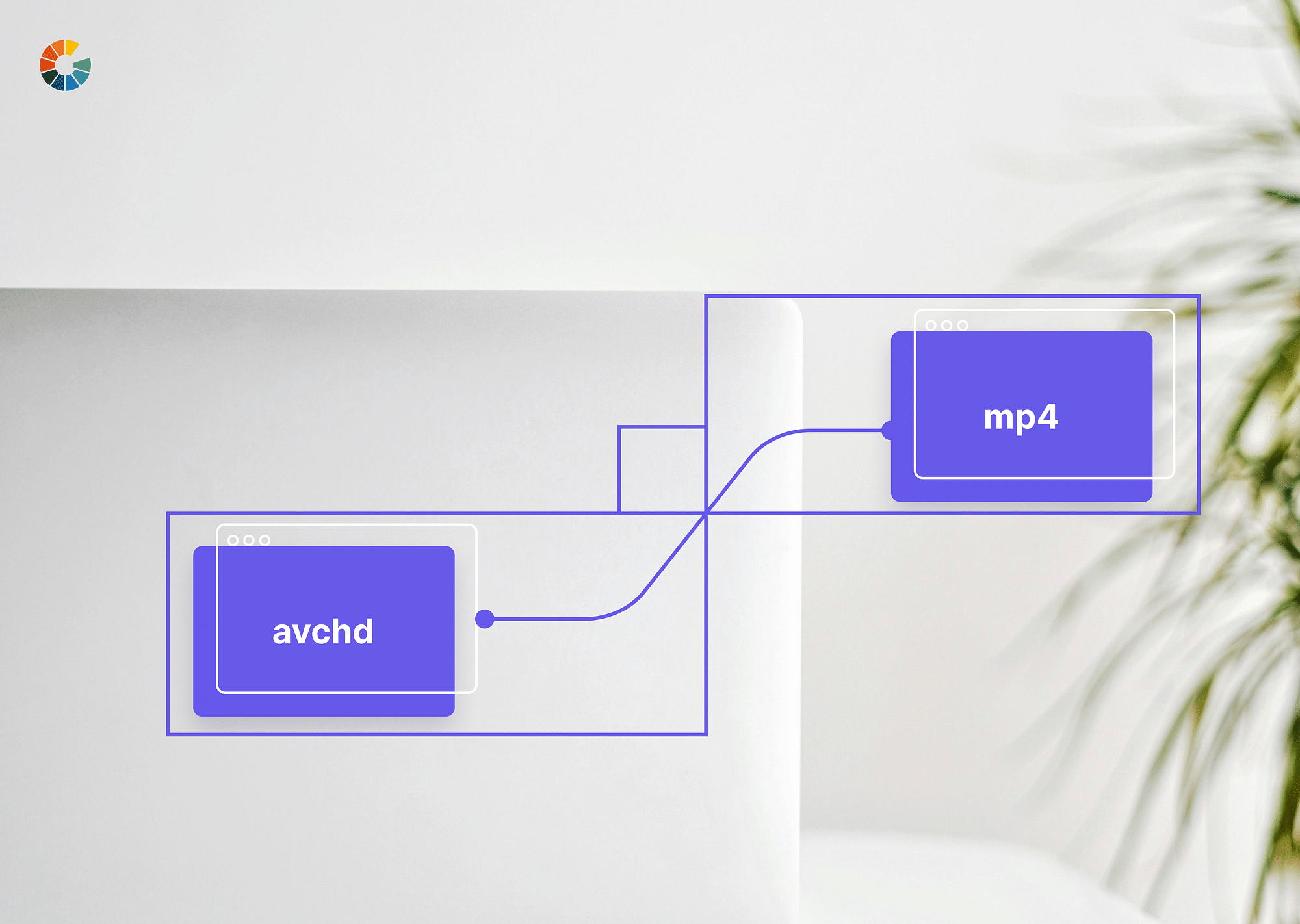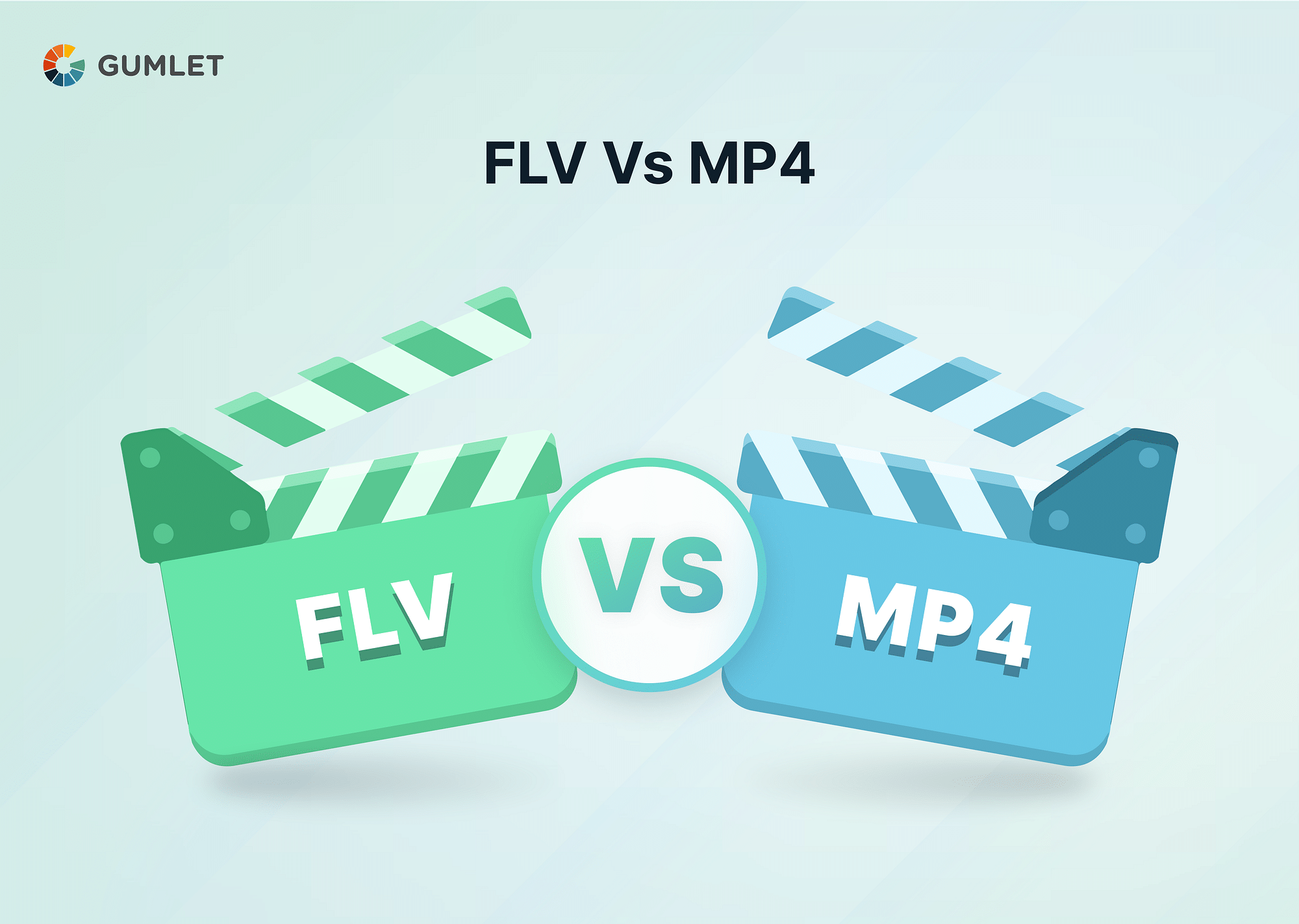What are Video File Formats?
Video file formats are unique file formats used to store video data digitally. Every video clip you come across on your mobile, desktop, or TV has a unique format — MP4, WEBM, AVI, MOV, MKV, and more. For instance, the file format of the audio/video content you post on social networking sites differs from that on VOD streaming services.
A video file typically comprises a container consisting of visual and audio data present in the different video and audio coding formats, respectively, and a video codec; that encodes and decodes audio and video files. Once encoded, the compressed data is stored in the container—or file format. Containers also contain subtitles and other metadata— reflected in the file’s extension.
The most commonly used container formats are MP4, WEBM, MOV, and so on. Some widely used codecs are H.264 and H.265 — both highly efficient at preserving video quality after video compression.
Different codecs are paired with varying formats of containers to enhance the compatibility of a video file with different devices and programs.
List of Top Video File Formats
With the sheer number of video file formats out there, choosing the right file format for your videos can be confusing. Here's deep-diving into the top video file formats to give you a deeper understanding of video file formats:
MP4
MPEG-4 Part 14, or MP4, is a highly versatile video file format that offers compatibility with various players and devices. Launched in 2001, it is currently the most widely used video file format globally for encoding video. MP4 is highly efficient at compressing video files while retaining high video quality.
Use-case
MP4 is most commonly used for streaming over the internet. For instance, videos posted on social networking sites like YouTube, Facebook, Twitter, and Instagram.
Pros and Cons
| PROS | CONS |
|---|---|
| It allows high-level compression without majorly affecting video quality. | It is a “lossy” compression format—which means that repeat encoding can lead to loss of information and visible quality deterioration. |
| You can store text, audio, video, and images and attach metadata to MP4 files, making it compatible with most digital platforms and devices. | MP4 files are susceptible to the unlawful distribution of content since you can easily remove the metadata. |
| MP4 can be used with a wide array of players like Microsoft Windows Media Player, and QuickTime Player, VLC. | MP4 files tend to use significant computing power because they contain both audio and video data. |
WebM
Created by Google, WebM is one of the most efficient video formats for distributing multimedia content to a broad audience base. This open-source video format compresses videos to relatively small sizes, which makes it a popular format for playing videos directly on your web browser. It should be noted, though, that the video quality of the WebM video format is not at par with other high-quality file extensions on this list.
Use-case
- The WebM video file type is used for playing videos on HTML5-based live streaming platforms like YouTube and Streamlab.
- It is primarily used for immediate playback and video sharing on major web browsers like Chrome and Edge.
Pros and Cons
| PROS | CONS |
|---|---|
| It has higher compression ratio as it is built for the internet. | It is not the most suitable format for mobile devices. |
| It doesn't require significant computational power because of smaller file sizes. | It is unlikely to support older players and browsers. |
| It is ideal for internet-based video services; Best option for live streaming. | The high compression ratio of WebM can deteriorate the original video quality. |
AVI
AVI is among the earliest and most widely supported digital video file formats in existence today, alongside MP4. Developed by Microsoft in 1992, it is compatible with a range of codecs, and video creators/editors can trade off quality with size and vice-versa, should they need to do so.
However, AVI files are still relatively larger in size than MP4, MOV, and WebM, which makes them unsuitable for the web and live streaming.
Use-case
AVI is supported by every major web browser and operating system like Windows, Mac, or Linux. One of its most common use cases is the TV — which could be the reason behind AVI's decline in recent times.
Pros and Cons
| PROS | CONS |
|---|---|
| It is mostly used to store large files on computers or share short videos like trailers, advertisements, and more. | Uncompressed AVI files can be relatively large. However, compressing beyond a limit can cause a significant deterioration in quality. |
| Supported by all the major players, OS (Microsoft and non-Microsoft), and internet browsers. | It demands greater storage space than other video file formats. |
| It is known to maintain high-end video and audio fidelity. | It is not suitable for live streaming. |
| It can be used for creating DVDs. | It does not preserve video quality after compression and other video formats. |
MOV
MOV is a digital video file format developed by Apple to support playback on the QuickTime player. The MOV file format consists of multimedia elements such as timecodes, videos and audio, subtitles, and more. It requires high computational power and storage space since it generates very high-quality video.
Barring QuickTime Player and a few other multimedia playback platforms, MOV is incompatible with most players and platforms.
Use-case
MOV is a global standard for the professional editing of videos. It is compatible with the various versions of QuickTime Player—on both Windows and Mac.
Pros and Cons
| PROS | CONS |
|---|---|
| MOV is highly efficient and convenient for storing digital files. | MOV files have very few other practical uses case apart from video editing. |
| A compact container for multimedia, storing text, timecode, video, audio, and subtitles as separate tracks. | MOV does not support multimedia playback platforms other than the different versions of QuickTime and VLC. |
| It is supported by a host of codecs and social media platforms, like YouTube and Facebook. | File sizes over 4GB on internet-based platforms like Facebook and Instagram are not supported by MOV. |
| Provides exceptionally high-quality video since compression barely affects video quality. | They require more storage space because of larger file sizes. |
MKV
Launched in 2002, MKV—or the Matroska Multimedia Container—is a free, open-source file format used for storing an unlimited amount of audio and video content, including movies and TV shows. MKV is similar to MP4 in that both file formats can store text, images, subtitles, and other metadata. However, MKV's distinct features give it an additional advantage in terms of support for a greater number of codecs for encoding and decoding and higher video quality.
In addition to this, since MKV is a non-proprietary software, it is considered a universal file format.
Use-case
- MKV is most commonly used for streaming HD and online videos.
- It is used by the VLC Media Player, Windows Media Player, DivX Player, and more.
- It is an all-in-one video file format that is compatible with almost all video/audio coding formats — even those not supported by mp4.
Pros and Cons
| PROS | CONS |
|---|---|
| It is a universal, open-source file format. | It does not offer widespread support for platforms and devices. |
| It undergoes regular updates to improve compatibility with novel platforms. | The compression technique employed by MKV is relatively complicated. |
| It can store any number of still images, subtitles, and metadata. | MKV's compressed files are comparatively larger, despite the similar quality. |
WMV
WMV—or Windows Media Video—is a popular video file format developed by Microsoft. It provides high compression, which ensures smaller file sizes—but not without significantly deteriorating video quality.
WMV is supported by Windows Media Player and most other Windows programs but has limited compatibility with other platforms. It works both as a container and codec as opposed to other video file formats. Another advantage is that WMV video files often come protected by video DRM technology.
Use-case
- WMV format is best-suited for storing large-sized video content since it doesn't require much storage space.
- It is supported by Windows-based programs, including earlier version software such as the older PowerPoint.
Pros and Cons
| PROS | CONS |
|---|---|
| It can store copious amounts of data without requiring considerable storage space. | It is not considered a standard, versatile video File format due to its limited support for different platforms. |
| WMV is quite useful if you need to send a video to someone who uses an older version of Windows. | Barring Windows systems, WMV does not offer extensive compatibility with other platforms and devices. |
| It offers twice as high compression as the MPEG-4 file format. | You do not have the option to alter the compression ratio manually. |
AVCHD
AVCHD—or Advanced Video Coding High Definition—the file format is used for creating HD recordings for playback on an HDTV. Developed by Panasonic and Sony, it is used by digital camcorders to store DVD and Blu-ray media on hard disk drives and memory cards.
AVCHD is a file-based format that uses the H.264 codec or MPEG-4 codec for the playback of HD video. Compared to MP4, AVCHD video files are harder to move, copy or upload to the internet or other portable devices.
Use-case
- Digital camcorders use it to record and play back high-definition videos.
- It is used to store HD files on Blu-ray, hard drives, and memory cards.
Pros and Cons
| PROS | CONS |
|---|---|
| Supported by Blu-ray, hard drives, and memory cards. | The video editing of AVCHD files can be rather be a very long and difficult task. |
| It provides high-definition video quality with AC-3 Dolby Digital codec. | It is not widely supported by a lot of Devices and platforms. |
FLV
FLV—or Flash Video—has the video file extension '.flv' and leverages the Adobe Flash Player plugin to distribute digital video/audio content over the internet. FLV files can be opened using Adobe Animate, VLC, Winamp, and more.
FLV is a widely supported and versatile file type that can be played directly on your browser and even be downloaded and shared. However, it is not compatible with iPhones and many other smartphones.
As HTML5 is becoming the preferred choice for sites and VOD services, the FLV file format has shown a decline in recent times.
Use-case
- FLV is used in the distribution of audio or video content over the web via the Adobe Flash Player.
- It is used for online video streaming by sites like YouTube.
- It is supported by Adobe Animate, Media Player Classic, VideoLAN VLC media player, and more.
Pros and Cons
| PROS | CONS |
|---|---|
| The majority of browsers & devices support it. | FLV files are not compatible with iOS devices. |
| It is an excellent option for streaming online videos. | These files are gradually being replaced by HTML5. |
How to Choose the Best Video File Format?
The choice of your video file extensions will depend on your requirements. It should provide the quality you require, be compact and shareable, and compatible with the device, browser, or player it will be streamed on. Here's how you can choose the right video file format for your use case:
- If you are streaming online videos, you need a file format compatible with all major web browsers. MP4 and WEBM are two good options for online streaming.
- For videos recorded using a phone camera or camcorder, you need a high-quality video file format. MP4 and AVI are well-suited and practical formats for this purpose.
- The video file format should also be supported by different operating systems. For example, for Windows applications, a Windows-supported format like WMV is a great choice.
Let's look at the best file formats based on the platform:
Best Video File Format for Instagram
Instagram supports both MP4 and MOV for videos. It accepts different accept ratios, square, 9:16, 4:5 for different post formats. Ideally, MP4 is the preferred file format compressed using the H.264 codec since it produces comparatively smaller file sizes and does not cause major deterioration in quality.
Best Video File Format for YouTube
To ensure smooth playback, YouTube recommends using the MP4 video file format which provides high quality at smaller sizes. It is best to opt for the H.264 video codec and maintain an aspect ratio of 16:9.
You can use tools like InVideo’s YouTube Video Editor to make the required changes to your file (crop, merge, overlay, etc).
Best Video File Format for Facebook
You can opt for WMV, MP4, FLV, MOV, MKV, and more for videos streamed on Facebook. However, MP4 or MOV are recommended for best results.
How to convert video file formats?
Converting uncompressed video formats involves transcoding or remuxing to produce desired outputs. Here are three powerful tools to convert video file formats:
- Video Converter Factory
You can opt for free video file converters like Video Converter Factory, which supports multiple input formats and provides swift compressions. You will have the option to extract audio from video or simply convert audio files as well.
- Cloudconvert Video Converter
Cloudconvert is a cloud-based video converter that allows users to convert their video files without the need to install additional software. It supports a wide range of video formats, including AVI, MP4, MOV, WMV, and WebM. Users can convert videos for use on any device, from smartphones and tablets to TVs and gaming consoles.
- Freemake Video Converter
Freemake Video Converter is a powerful video conversion tool. It supports a wide range of formats, has basic editing tools, and offers advanced options for more experienced users. The program can convert between AVI, MP4, MPG, WMV, FLV, 3GP, and MKV, as well as MP3 and WAV.
Most Common Video File Formats
Perhaps you want to start a VOD service, upload high-quality videos to your website, or simply store some HD clips on a portable device. Different browsers, platforms, and devices support different video file formats—depending on the use case and your video quality requirements as to which file format you should choose.
Here's a brief overview of what we've discussed so far:
- MP4: It is a universal standard compatible with every major browser, OS, and OTT platform, best suited for streaming platforms and mobile devices.
- WebM: It is an excellent choice for live streaming and online libraries.
- MOV: It is a safe bet for distributing content across iOS devices.
- AVI: It is a good choice for short promos, teasers, and ads.
- MKV: It is used for streaming HD and online videos with multiple audio options, menus, etc.
- WMV: It is recommended for storing large-sized video content since you can save space.
- AVCHD: It is used for recording and playback of HD content.
For streaming online videos, choosing a file format compatible with the widest range of web browsers is best. MP4 and WEBM are popular options in this regard, having compatibility with all major browsers. In addition to this, it provides decent video quality without demanding significant storage space.
Conclusion
We hope this detailed blog will help you determine the best video file format for editing, sharing, and distributing your videos.
Whether you are looking for video file formats to launch an OTT streaming service or share online videos over the web, Gumlet leverages the latest codecs to build high-quality video products in your desired video formats.
Try Gumlet for free now!
FAQs
- Which video format is the smallest?
While video size is dependent on the codec used, the resolution, compression ratio, etc, for general purposes, the MP4 H.265 codec produces the best results. It is one of the most efficient file formats which is used in the compression of 8K UHD video.
2. Is MKV better than MP4?
Both MKV and MP4 support UHD resolution and use the HEVC video codec for encoding. However, MKV also supports FLAC as opposed to MP4—which makes MKV the preferred lossless compression format. MKV is also highly flexible and universal; it can store an unlimited number of files—be it images, videos, or metadata.
3. What format is best for videos?
There is no one-size fits all format for video; it typically depends on the quality, size, storage, etc, requirements of the user. Some of the best formats include MP4 (MPEG-4 Part 14); which is best for smaller-sized videos for streaming over the internet, AVI; which produces the highest quality, MKV; which is the most flexible file formats in the market, and so on.
4. What is the best file format for HD video?
MKV or AVCHD are the best file formats for HD videos. MKV is universally compatible and produces high-quality pictures and sound quality. While AVCHD is not as widely supported, it is also best suited for high-definition videos. For lower qualities, MP4, AVI or WMV are better options.
5. Does a bigger video file mean better quality?
Bigger video size doesn't necessarily mean better quality. Video quality depends on the file format used and the compression level. For example, AVCHD files provide high-definition video quality but, at the same time, are compact and easy to share.




